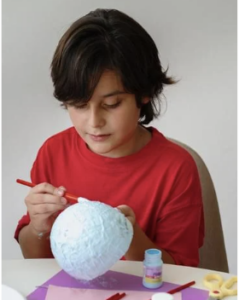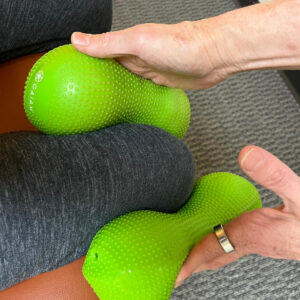It Was Just a CAST. What’s the Big Deal? Ask Your Muscles. 😶
Your Cast and an Elusive Recovery
Immobilized muscles are a BIG DEAL!
Recently I’ve written about how the area affected by the cast can be the source of your aches and pains, stiffness, or poor coordination. Link here. And, about how a cast impacts growth patterns of children’s muscles. Link here.
But you’re still thinking, “Why is a cast such a big deal? My ___ can move. It’s my ___ that’s bothering me.”
You may think your arm or leg look fine, and can move, but we find there is more to feeling good — a case of what’s missing.
To help understand this, let’s turn to something most of us are familiar with—water balloons. I’ll also share how Bridging®, uniquely, resets layers of muscles and movement related to immobilization and its compensations.
Water Balloons, Muscles, and Wiggly-jiggly
Think of a nicely filled water balloon — it’s roly-poly, wiggly-jiggly, and bouncy. You might not realize it, but every part of your body should have some version of that movement.
This wiggly-jiggly quality (scientifically referred to as tissue viscoelasticity) is a good thing! It means your muscles, blood vessels, nerves, fascia, and connective tissues can move and glide over each other with minimal restriction.
When your muscles have been immobilized, the physics of the movement flow within your body gets disrupted. It is diverted, amplified, or shut down, all of which are bad for your body and its ability to move.
 Paper Maché, Muscles, and Feeling Stuck
Paper Maché, Muscles, and Feeling Stuck
When a cast is put on your body (for a broken bone, surgery, tendon repair, etc.), it’s like covering a water balloon with paper maché. That wiggly-jiggly motion stops cold.
A cast serves a critical role in healing broken bones, tendon repairs, and post-surgical recovery by immobilizing movement to prevent further damage. However, it also comes with serious consequences for muscle function. Yes, even after just two weeks.
Muscle atrophy – Within one week of immobilization, muscle fibers shrink by up to 5%, and by three weeks, they can lose 30% of their strength.
Loss of neuromuscular coordination – The brain relies on sensory input from moving muscles. Immobilization reduces this input, weakening communication between the brain and muscles.
When the cast comes off, you are told that with a little bit of time and some exercises you’ll be back to original. NOT SO FAST!
Just because the cast is gone doesn’t mean your wiggly-jiggly movement patterns will automatically restore themselves.
 The FIVE Parts to Restoring Muscle Flow After a Cast
The FIVE Parts to Restoring Muscle Flow After a Cast
To fully restore your movement and coordination, your body needs to go through five key stages. Fortunately, these usually happen quickly with the Bridging® approach!
Stage 1: Wake Up Sleeping Muscles
After weeks in a cast, your muscles are like a stiff paper maché balloon in a bucket of water balloons. Everything else moves freely — except the one that’s been locked in place. To wake the muscles up, we use peanut balls to gently support and oscillate, enabling the wiggly-jiggly movement.
Stage 2: Remind Muscles to Move Together
Once the muscles wake up, they need to reconnect with the surrounding muscles above and below the immobilized area. This looks similar to Stage 1 with similar wiggles, but different support points.
Stage 3: Restore Muscle Activation Sequences
Muscles don’t just move individually — they follow automatic patterns developed from infancy. After being in a cast, these patterns need to be re-established. To do this we check a series of movement flows making sure part A connects to part B, to part C, etc.
Stage 4: Rebuild Core Muscle Support
Casts inhibit interactions with core muscle support. This is another phase of linking automatic activation sequences. This step reconnects those interactions for better posture and coordination to enable your balance and movement ease. Similar to connecting movement flows, in this stage we are checking specific movements emanating to and from the core muscles.
Stage 5: Clear Up Compensations
While wearing a cast, your body developed imbalances to work around the injury. These asymmetries need to be reset so your movement is smooth and effortless again. Again, this is another level of checking movement. This is often done using video to observe your body in action, and resetting the movements that need fine-tuning.
(FOR KIDS ONLY) Stage 6: Follow-up with growth
Kids’ bodies grow fast — and muscles that were immobilized don’t always adapt well during growth spurts. The younger the child, the more important this step is.
Bottom Line
The after-effects from having a cast DO NOT RESOLVE with stretching, exercise, or basic massage. That’s why lingering pain, stiffness, or balance problems often remain long after the cast is gone.
Common FAQs About Casts and Recovery
Q: Can Bridging® help if my cast was years ago?
✅ Yes! Muscle disruptions don’t resolve on their own. Bridging can restore movement — even years after an injury.
Q: Can I do Bridging® while in physical therapy?
✅ Absolutely! Many clients find that Bridging® helps them progress faster by ensuring muscles activate correctly during rehab exercises.
Q: What’s the ideal timing for Bridging® after getting a cast off?
Session 1: Within 2 weeks. Wake up atrophied muscles and restore basic motion.
Session 2: 3-4 weeks later. Improve coordination and address pain.
Session 3: 3–6 weeks later. Strengthen movement patterns and reset remaining limitations.
Future Sessions: As needed for agility, strength, or sports performance.

